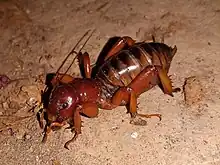| Stenopelmatus | |
|---|---|
 | |
| Stenopelmatus talpa | |
| Scientific classification | |
| Domain: | Eukaryota |
| Kingdom: | Animalia |
| Phylum: | Arthropoda |
| Class: | Insecta |
| Order: | Orthoptera |
| Suborder: | Ensifera |
| Family: | Stenopelmatidae |
| Subfamily: | Stenopelmatinae |
| Tribe: | Stenopelmatini |
| Genus: | Stenopelmatus Burmeister, 1838 |
| Synonyms | |
|
Stenopelmatopterus Gorochov, 1988 | |
Stenopelmatus[notes 1] is one of two genera of large, flightless insects referred to commonly as Jerusalem crickets (or "potato bugs"). They are primarily native to Central America, and one species is known from Ecuador.[2]
Classification
There are 19 species recognized as valid in the genus Stenopelmatus, as presently recognized (with 13 more of uncertain status and potentially not valid), though the genus was formerly much larger, including most of the species now placed in the genus Ammopelmatus.[2] The family Stenopelmatidae contains several Old World genera, but only the genera in the subfamily Stenopelmatinae (all New World) are referred to as Jerusalem crickets.
Valid species
- Stenopelmatus ater
- Stenopelmatus chiapas
- Stenopelmatus cusuco
- Stenopelmatus diezmilpies
- Stenopelmatus durango
- Stenopelmatus ecuadorensis
- Stenopelmatus faulkneri
- Stenopelmatus honduras
- Stenopelmatus hondurasito
- Stenopelmatus mineraldelmonte
- Stenopelmatus nuevoleon
- Stenopelmatus perote
- Stenopelmatus piceiventris
- Stenopelmatus saltillo
- Stenopelmatus sanfelipe
- Stenopelmatus sartorianus
- Stenopelmatus talpa
- Stenopelmatus typhlops
- Stenopelmatus zimapan
Uncertain status
- Stenopelmatus calcaratus
- Stenopelmatus erythromelas
- Stenopelmatus guatemalae
- Stenopelmatus histrio
- Stenopelmatus lessonae
- Stenopelmatus lycosoides
- Stenopelmatus mexicanus
- Stenopelmatus minor
- Stenopelmatus nieti
- Stenopelmatus sallei
- Stenopelmatus sumichrasti
- Stenopelmatus toltecus
- Stenopelmatus vicinus
Communication
Similar to true crickets, each species of Jerusalem cricket produces a different song during mating. This song takes the form of a characteristic drumming in which the insect beats its abdomen against the ground.
No species have wings with sound-producing structures; moreover, evidently none has structures it could use to hear sound.[3][4] This contrasts with true crickets and katydids, who use their wings to produce sounds and have hearing organs to sense sounds of others. Jerusalem crickets seem unable to hiss by forcing air through their spiracles, as some beetles and cockroaches do. Instead, the few Jerusalem crickets that do make sound rub their hind legs against the sides of the abdomen, producing a rasping, hissing noise. This hiss may serve to deter predators rather than to communicate with other crickets. For such purposes, Jerusalem crickets rely on substrate vibrations felt by subgenual organs located in all six of the insect's legs.[5]
Size and shape
Female Stenopelmatus talpa, also known as the Mexican Jerusalem cricket, are generally larger than males; prothorax width, prothorax length, fore femur, head size, and mandible length, are greater in females than males. However, males tended to have larger hind femora compared to females.[6]
Notes
References
- ↑ στενός, πέλμα. Liddell, Henry George; Scott, Robert; A Greek–English Lexicon at the Perseus Project.
- 1 2 D.B. Weissman, A.G. Vandergast, H. Song, S. Shin, D.D. McKenna, N. Ueshima (2021) Generic relationships of New World Jerusalem crickets (Orthoptera: Stenopelmatoidea: Stenopelmatinae), including all known species of Stenopelmatus. Zootaxa 4917. DOI:10.11646/zootaxa.4917.1.1
- ↑ L. Desutter-Grandcolas (2003). "Phylogeny and the evolution of acoustic communication in extant Ensifera (Insecta, Orthoptera)". Zoologica Scripta. 32 (6): 525–561. doi:10.1046/j.1463-6409.2003.00142.x. S2CID 85659457.
- ↑ Robinson, DJ; Hall, MJ (2002). "Sound Signalling in Orthoptera". Advances in Insect Physiology, Volume 29. Elsevier. pp. 151–278. ISBN 978-0-12-024229-0.
- ↑ Weissman, DB; Vandergast, AG; Ueshima, N (2008). Encyclopedia of Entomology. Berlin: Springer. pp. 2054–2061. ISBN 978-1-4020-6242-1.
- ↑ Álvarez, Hugo A.; Sánchez-Xolalpa, Dinorah A.; Torre-Anzúres, Josué De la; Jiménez-García, Daniel (September 2017). "Morphometry, behavior, and ecology of the Jerusalem cricket, Stenopelmatus talpa". Southwestern Entomologist. 42 (3): 745–752. doi:10.3958/059.042.0313. S2CID 90924229.
External links
![]() Media related to Stenopelmatus at Wikimedia Commons
Media related to Stenopelmatus at Wikimedia Commons